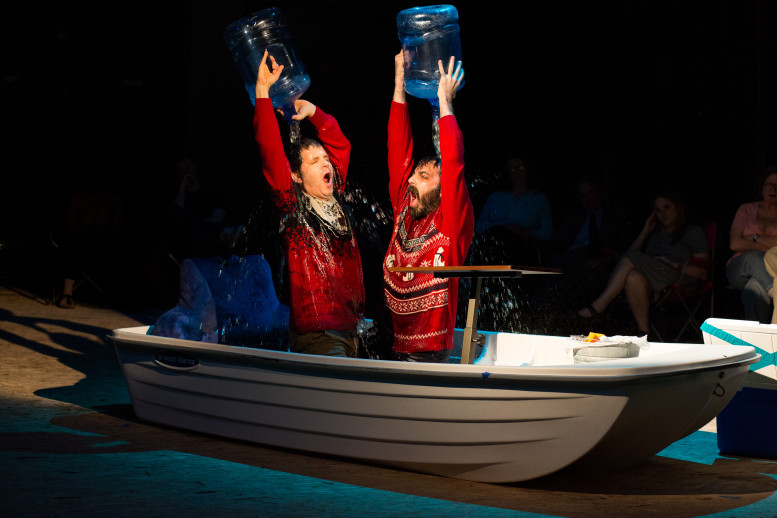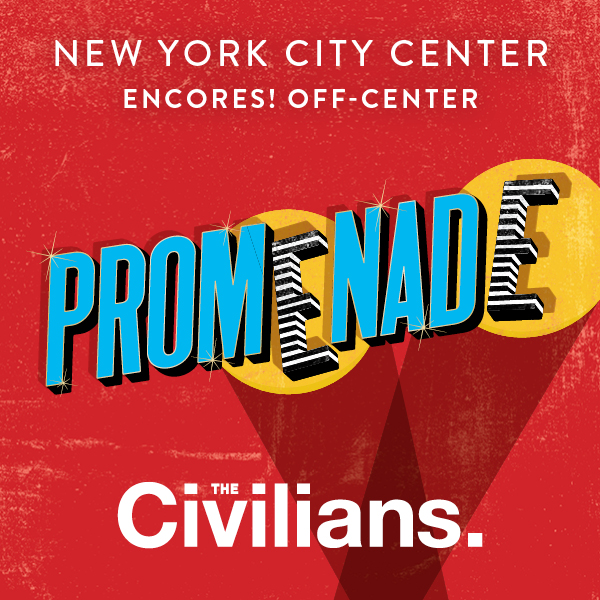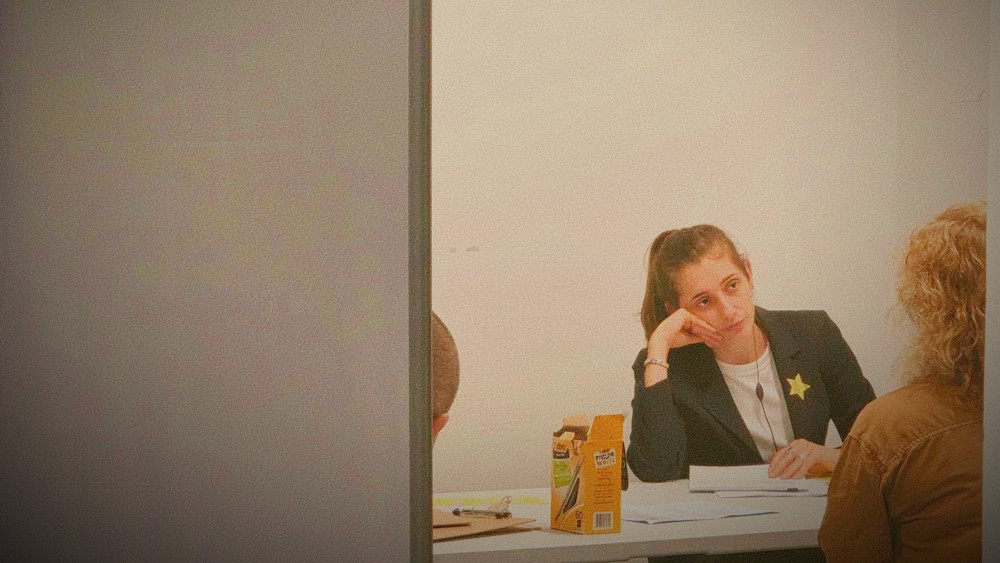It’s always fun to see a workshop of a play and then catch it later when it becomes a full-fledged production. The final product sometimes looks very much like the workshop, and other times, it’s been torn apart, reworked, and feels like a completely different play.
I recently had the pleasure of revisiting Sheila Callaghan’s play (or not a play) “(NOT) WATER” at 3LD Arts and Technology Center produced by New Georges, after attending a workshop of it years several ago. There were scenes and moments that jogged my memory back to the evening I saw the workshop, but in many ways, this is a very different “non-play.”
“We keep telling people, ‘This isn’t a play. This isn’t a play,’” says Sheila. “And it’s hard to distance yourself from the fact that a playwright and a director co-conceived a piece…and it’s still not a play.”
Sheila says they framed it as “not a play” to manage regular theatergoers expectations. “(NOT) WATER” does not employ your typical three-act structure. In fact, there isn’t much structure at all. It’s an immersive event, and like many immersive events, it unfolds as short vignettes in multiple locations throughout 3LD. It offers a giant flood in the form of a massive hanging installation designed by Deb O under which the entire audience rests on inflatable floaties.
“I wanted to show that fuckin’ island of crap that’s out in the world,” Deb says. “We don’t even know where it is. Every once in a while we see a picture of it. Who’s doing what to get rid of that? It makes me so angry. And hanging that was going to be my big ‘fuck you’ to everybody.”
The structure was originally conceived as a wall hanging, but once it became clear they were structuring the final act as a meditation, Deb realized they needed to hang the installation on the ceiling and allow the audience to take it in from beneath. But when she had the idea, she was hesitant to suggest it.
“That’s not really what we do in the theater. We don’t hang things on the ceiling and tell everybody, ‘Come in and lay down!’ So it was kind of a scary place to go, but I love being frightened by theater.”
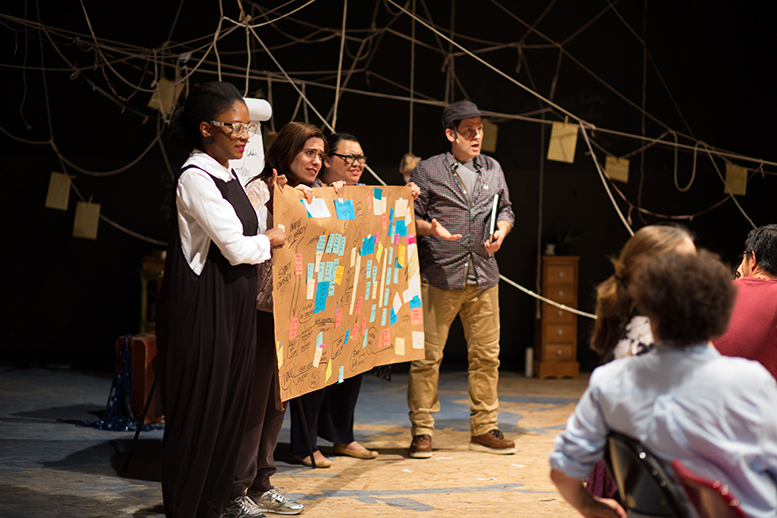
“(NOT) WATER” also radically shifts its structure from the workshop by including Sheila, Daniella, and the show’s designers as characters in the narrative. Daniella is “DT,” and Sheila is “Not Sheila.” This conceit explores the questions the collaborators asked each other over the ten years of development.
That’s right: Sheila and Daniella have been developing this non-play for over ten years.
“What we found ourselves struggling with was the framing device,” Sheila explains. “How do you land on a structure that supports all the things we already built? And we just kept playing with different ideas, and nothing seemed to be landing. We couldn’t figure out why this thing was constantly shifting beneath our feet.”
Sheila wrote a draft depicting the creative team searching for a structure, which included many topics surrounding water, but it didn’t highlight any one issue because they found it challenging to know where to start and where to end with a subject so big.
“American audiences do this in a way other countries—I can only speak to European countries I’ve been in,” says Sheila, “where they don’t make the same demands on the storytelling of their theater, of their plays that we do in the U.S. And I’ve found this to be the case with a lot of my work that is more traditional. People feel safer in it.”
But with “(NOT) WATER” Sheila wants the experience to wash over the audience. She doesn’t want to offer answers. Only opportunity. And that’s what she seems to wish for the future of plays, generally.
“How can we see this outside of having to make sense of it as a document with a beginning, middle, and end and a single-minded purpose?” Sheila asks. “Which is how a lot of us tend to watch theater. Like, ‘What are they saying? What does it mean? What are the answers? Why isn’t it telling us things that we sat down to know about?’”
Daniella sees “(NOT) WATER” as a framework on which to hang a series of discoveries, experiments, meditations, and encounters.
“We kept trying to shove it into what would be more of a ‘well-made play’ or something linear,” says Daniella, “and actually that whole thing ended up feeling super contrived. The framework is a helpful, loose structure to let people into the topic and the various experiments and discoveries.”
Finding new ways to engage audiences excites Daniella. She displays curiosity about how the audience meets the work and the subject of water.
“In the process of 100 minutes, they’re taking time to meditate about water in different ways,” says Daniella. “I think it’s been so complex because, as the piece tries to reflect, our conversations about water politically and scientifically have really changed over the years. I guess the micro of that is that they’re even changing in that 100 minutes, in a way. It feels endlessly complex in a way that I find very fascinating.”
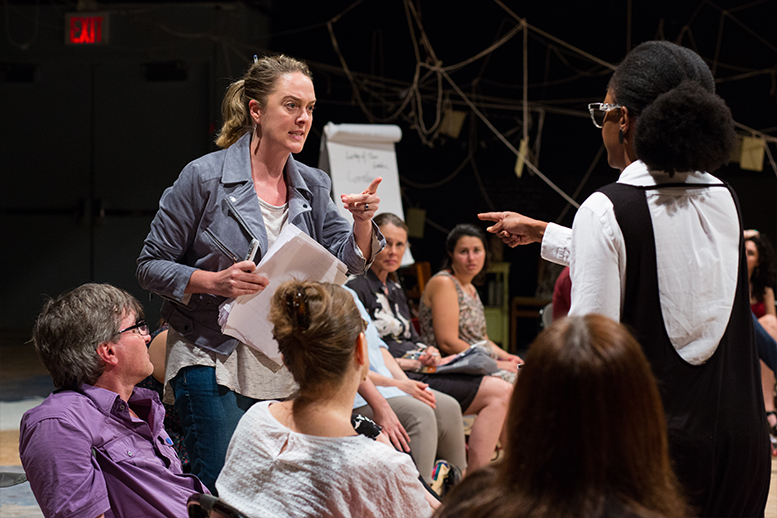
In addition to “(NOT) WATER,” the month-long collaboration of Works on Water includes an art exhibition conjunction with New Georges, Guerilla Science, Urban Water Artists, and 3LD. The artists’ exhibition lives in the space, and just before the show begins, the production team strikes some of the art for the actors to play. But all throughout, the art rests along the perimeters, propping up the main action in a center circle created by the audience, who mostly sit in chairs.
“I’m really impressed with New Georges for being able to pull off the scope of engagement. I think there are many different ways for people to engage. I think the theater piece is one piece, but I think those visual art exhibits are deeply compelling, also balancing art and science in very unique ways.”
Daniella half-jokes about taking the show on the road to see how the piece plays in different parts of the world, but its immersive nature and large scope is a daunting prospect. But if they choose to share the piece again, no doubt its structure will ebb and flow, much like our ever-changing relationship with water.
Author
-

James Carter is a writer and experience designer. He was a founding member of terraNOVA Collective and its associate artistic director for eight years. Recent transmedia plays include "FEEDER: A Love Story" (terraNOVA/HERE, NYC) and "NY_Hearts" (One Muse Presents & The Brick Game Play Festival). James also works as a social impact strategy and research consultant for Lina Srivastava, LLC. He has written for the Creators Project, Culturadar.com, ArtsFwd and Theatre Communications Group.
View all posts


